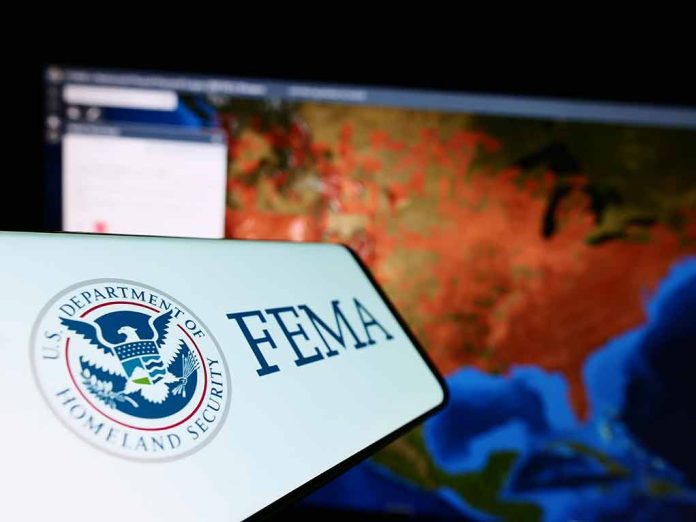
Trump orders overhaul of disaster response as plan emerges to phase out FEMA and empower states to handle their own emergencies, challenging the bloated federal agency that has repeatedly failed Americans during their most desperate times of need.
Key Takeaways
- President Trump has initiated a plan to phase out FEMA after the 2025 hurricane season, shifting disaster response responsibilities to state governments
- The reform includes establishing a FEMA Review Council led by Homeland Security Secretary Kristi Noem and Defense Secretary Pete Hegseth to restructure disaster response
- Trump cited FEMA’s bureaucratic inefficiency, slowness, and high costs as primary reasons for the overhaul
- The plan would provide disaster relief funding directly to state governors, bypassing federal bureaucracy and putting accountability at the local level
- Critics warn some states may lack sufficient resources to handle major disasters without federal coordination
Trump’s Bold Vision for State-Led Disaster Response
President Donald Trump has announced a significant overhaul of the United States’ disaster response system, planning to phase out the Federal Emergency Management Agency (FEMA) after the 2025 hurricane season. The initiative aims to transfer disaster response authority to state governors, whom Trump believes are better positioned to address local emergencies. The plan represents a fundamental shift in emergency management philosophy, prioritizing local knowledge and immediate response capabilities over centralized federal control. This reform follows growing frustration with FEMA’s performance during recent disasters and aligns with Trump’s broader agenda to streamline government operations.
“We want to wean off of FEMA, and we want to bring it down to the state level,” said President Donald Trump, addressing concerns about the federal agency’s effectiveness. The president’s executive order has established a comprehensive review of FEMA’s operations, specifically targeting what many conservatives have long criticized as unnecessary bureaucracy that often impedes rather than facilitates disaster recovery. By transferring responsibility directly to governors, Trump’s plan introduces greater accountability while preserving federal financial support through a more streamlined distribution system.
FEMA’s Troubled Legacy Prompts Reform
FEMA’s performance during recent disasters has raised serious questions about the agency’s effectiveness despite its massive $30 billion budget. Hurricane Helene’s aftermath proved particularly problematic, reinforcing concerns that the federal bureaucracy creates unnecessary delays in delivering critical aid to affected communities. Trump didn’t mince words when assessing the agency’s record, highlighting its structural flaws that have frustrated both disaster victims and local officials trying to rebuild their communities. The president’s critique reflects growing conservative sentiment that centralized federal agencies often create more problems than they solve.
“FEMA has been a very big disappointment. They cost a tremendous amount of money. It’s very bureaucratic and it’s very slow,” said Trump.
The Review Council, led by Homeland Security Secretary Kristi Noem and Defense Secretary Pete Hegseth, faces the substantial task of reimagining disaster response without the federal agency that has coordinated these efforts for decades. Secretary Noem has already indicated that FEMA needs to be dismantled in its current form, signaling that the administration is serious about implementing fundamental changes rather than minor reforms. The initiative comes as NOAA forecasts 6-10 hurricanes for the upcoming season, with 3-5 expected to develop into major storms, creating urgency for implementing an improved response system.
Balancing State Authority with Practical Realities
Trump’s plan places considerable emphasis on gubernatorial leadership during disasters, introducing a new paradigm of accountability. “A governor should be able to handle it, and frankly, if they can’t handle it, the aftermath, then maybe they shouldn’t be governor,” Trump stated, reinforcing his belief that disaster management should primarily fall under state jurisdiction. This approach aligns with constitutional principles of federalism while challenging the decades-long trend toward expanding federal involvement in areas traditionally managed by states. The shift represents a return to more traditional governance models that conservatives have long championed.
Critics have raised concerns about the financial implications for states, particularly those prone to natural disasters. An Urban Institute analysis suggests that shifting disaster costs to states could amount to $41 billion based on 2008-2024 data. States along the Gulf Coast, which face frequent hurricanes, might struggle to bear these additional financial burdens without federal support. However, supporters of Trump’s plan counter that the elimination of bureaucratic waste could potentially free up resources to provide more direct aid to affected communities without the administrative overhead that currently consumes substantial portions of disaster relief funding.
Implementation Timeline and Legislative Hurdles
The administration has strategically planned to begin the transition after the 2025 hurricane season, providing time for states to develop their enhanced disaster response capabilities. This phased approach demonstrates Trump’s practical understanding of the complexities involved in restructuring emergency management systems. Fully dismantling FEMA would require Congressional action, including amendments to the 1988 Stafford Act, which currently governs federal disaster assistance. With Republican control of Congress, these legislative hurdles appear surmountable, though the process will likely involve extensive negotiations to ensure effective implementation.
Some federal lawmakers, including Democrats like Rep. Jared Moskowitz, acknowledge the need for reform while preferring to restructure rather than eliminate FEMA. This suggests potential for bipartisan cooperation on improving disaster response, even if disagreements remain about the extent of changes needed. The Trump administration appears confident that their approach will yield a more responsive, efficient system that better serves Americans during their most vulnerable moments. As hurricane season approaches, the coming months will be critical for developing the framework that will reshape American disaster response for generations to come.













